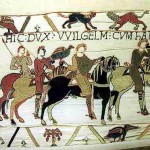Bayeux Tapestry: The Bayeux Tapestry tells the story of the events leading up to the invasion of England by William the Conqueror and it is actually embroidered cloth and a mixture of words and images.
This course has been challenging, engaging and even frustrating at times and I have enjoyed it from beginning to end. Making connections through the course requires looking for the common threads and weaving them together to tell the final story. Together, I am sure we will discover all the threads and weave our final tapestry. I would like to weave a thread about literacy and the issues of universality in the digital age.
Bolter acknowledges “the key problem that the technology is not universally available” (p. 205) in his final chapter and in the discussion of text and technology. Several commentaries and projects explored the universal access and place of digital literacy today. Leonora examines the importance of critical digital media skills while Doug writes about the same issue in the post secondary system. Juliana shifts the focus to the changing face of literacy for apprenticeship training. Jennifer’s presentation shows how we can use the idea of multiliteracies to include the marginalized. We discussed the impact of the lack of literacy skills but mostly we learned how literacy has changed the world and as the definition of text and literacy changes, it continues to do so.
I read with interest the last two chapters of Bolter’s Writing Space while I was busy still reflecting on the MET program for my ePortfolio in ETEC 590. I have been revisiting the courses I have taken – rereading, thinking and reflecting on the material with an eye to the connections between courses and my own learning. What has surprised me the most is the realization that taking ETEC 540 as my last course was the perfect way to weave it all together. From reading Bolter, Ong, other course readings and the fantastic material contributed to our Community Weblog, I realized that our explorations of text and technology are deeply connected to the rest of the program by the many references to theories, authors, and concepts in other courses that are now woven together with text and technology as the threads. Looking back helped me to situate text and technology as the warp and the weft of my tapestry of learning and no, my eP metaphor is not weaving ;). A very rewarding way to finish up the MET program!
Thanks for all the collaboration and generous sharing of ideas.
References:
http://commons.wikimedia.org/wiki/File%3ABayeux_hawking.jpg




Congratulations Lynette!
Kim :)
Thanks Kim!